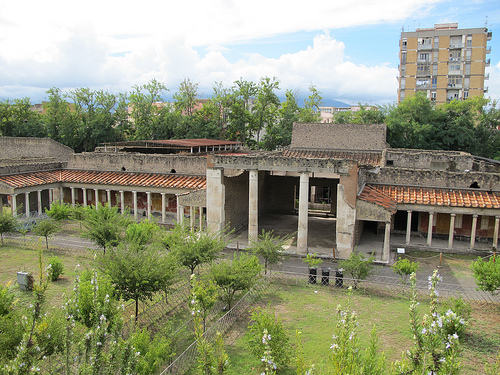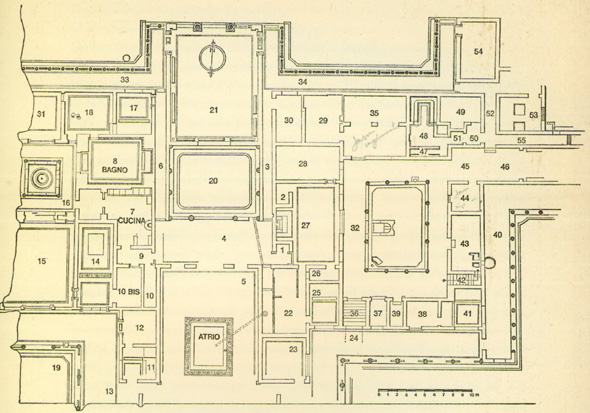

Location: Oplontis, Campania Map
Plan of the villa Poppaea in Oplontis

Oplontis is a city buried by mount Vesuvius eruption of August 24th, 79 AD along with Pompeii and Herculaneum. It is located in modern city of Torre Annunziata. The most famous feature of Oplontis is Villa Poppaea once owned by second wife of emperor Nero. Poppaea Sabina did not live to see the destruction of her beloved home. In 65 AD she was killed by her husband who kicked her in the abdomen in the late stages of her pregnancy according to Suetonius. After death of Nero in 69 AD the Oplontis villa changed hands was probably in the state of reconstruction when eruption happened. Roof tiles were preserved thus preventing massive damages to the frescoes inside villa that are some for the most colorful and beautiful left since the Ancient Roman Empire. Although coins and jewelry were found inside the house, archaeologists did not discover remains of human victims. This led to suggestion that the inhabitants of the Oplontis villa had enough sense to abandon riches of the private residence and flee for safety.
Oplontis Washroom. Wooden seats was not get preserved, but gutter is still visible.
Villa of L.
Crassius Tertius aka Vila B of Oplontis has kept an interesting secret since
the eruption. On that August day mount Vesuvius quickly spew
tons of ash and geologic material into air. The skies over Bay
of Naples made everything dark. There was virtually no way to
get out of here without a torch or a lamp. Volcanic pumice was
falling down. So many decided to hide in the underground
structures. Unfortunately this proved to be a costly mistake.
Over 50 people were entombed in their underground hiding place.
One of the most striking things about this cache of skeletons in this part of Oplontis is a distinct difference in the social classes. Survivors of the first wave of an eruption even in a face of deadly threat separated into two groups. One was obviously rich, while another was obviously very poor. While analysis of both groups of skeletons showed relatively good nutrition and similar state of health, the items they took with them very different. Many in the rich group had golden bracelets, ear rings, silver and gold coins. One of the women carried over a sum that was equivalent to 10 years of annual pay to a regular Roman legionnaire. Another difference that divided the two groups was ironically the color of their bones. Those who had many bronze coins and bronze items had their bodies covered in a superficial patina of green color. Green color came from the oxidized metal that over time seeped through ground and covered bodies of its former owners. The poor group did not have none of such discoloration.
One of the surprising things that were discovered here two bodies of victims of obvious Sub- Saharan African descent. One man and one women were actually present in the rich group of skeletons. The body of a man, just like many other bodies of his class were covered by green patina indicating that he was buried along with some personal treasure.
One of the saddest archeological findings in Oplontis also lie near by. It is body of a woman who was pregnant at the time of the eruption. She obviously couldn't run from the danger and instead decided to stay in the cellar. It spelled here doom as well as death to her unborn child. Little bones that were discovered next to her indicated that she was in he ninth or eight month of pregnancy and was supposed to give birth very soon. She and her child were sealed underground where they died.
History
We have very fragmentary news of the
ancient Oplontis. His name appears for the first time during the
Middle Ages in the Tabula Peutingeriana. The site is indicated six
miles from Herculaneum and three from Pompeii and Stabiae, and
according to the indications of the map more than a real city, it
would be a suburban settlement of nearby Pompeii where there were
some holiday villas, several farms, salt and thermal complexes,
given the wealth of water in the area: in fact on the Tabula the
locality is represented with the symbol usually used for thermal
places, a thesis also attested by the remains of buildings used for
this function that were found in the Torre area Annunziata.
The whole area was buried under a blanket of ash during the eruption
of Vesuvius in 79 and a revival of life will only take place many
centuries later with the development of the modern city of Torre
Annunziata.
Toponym
Various hypotheses have been made
about the origins of the name Oplontis: it could derive from the
Latin opulentia ("opulent place"), opla ("fishermen's place"),
poplus ("poplar", or poplar grove where the espalier vine is tied)
or from the Greek oplon (post of hoplites, warriors with long
spears), apopolotes ("destroyed city"). Finally, an error by the
cartographer in the transcription has also been hypothesized, due to
the Latin phrase ob fontis («spring, thermal place») being present
in the area of the spa.
Archaeological excavations
In
the eighteenth century, under the influence of the archaeological
finds of Pompeii, Herculaneum and Stabiae, excavation campaigns were
also started in Oplontis, which were soon suspended both due to the
lack of funds and the nefarious air where these took place, i.e. in
a marshy area near the Sarno river. Since 1964, excavations have
begun on a villa called di Poppea and later on another villa called
by Lucio Crasso Tertius: to date neither of them has been fully
explored. In 1997 the excavations were declared a World Heritage
Site by UNESCO.